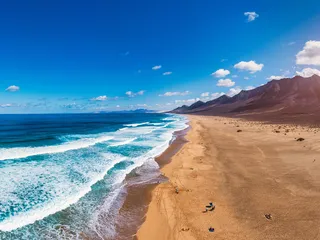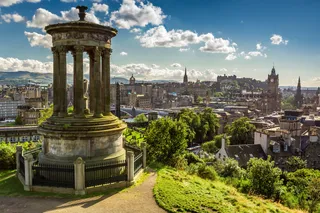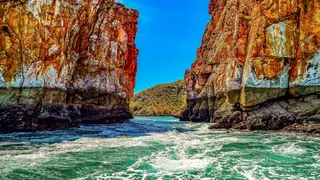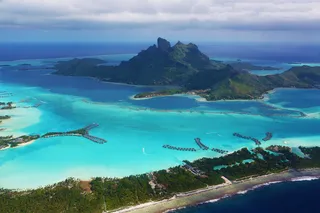_320x0.webp)
2025 Himalayan Harmony: A Nepal & Bhutan Adventure
Nov 07, 2025 - Nov 19, 2025- Kathmandu
- Pokhara
- Kathmandu
- Thimphu
- Punakha
- Paro
- Kathmandu
Olivia is Taking You to Nepal & Bhutan!
Join us for a 13-day adventure through Nepal and Bhutan, where you'll explore the heart of the Himalayas and experience the profound beauty and rich cultural tapestry of these enchanting lands. Begin your journey in Nepal, where you'll explore the bustling streets of Kathmandu, visit ancient temples, and marvel at the breathtaking landscapes from lush valleys to the towering peaks of the world's highest mountains. As you journey into Bhutan, the "Land of the Thunder Dragon," you'll be immersed in a realm of timeless traditions, pristine nature, striking monasteries perched on cliffs and the unique philosophy of Gross National Happiness that permeates every aspect of life. This extraordinary adventure promises an unforgettable blend of natural splendor, rich heritage, cultural immersion, and spiritual exploration, creating memories that will last a lifetime.
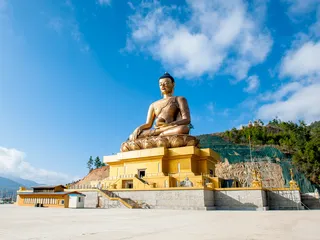
Activity Level: Difficult
This trip requires a high level of mobility as you must be able to walk long distances, up and down stairs of varying steepness and heights, up varied inclines, down varied declines, and over very uneven ground to do this tour. We will be doing quite a bit of walking, including a 4-mile nature hike with over a 1,000 ft of elevation gain and a hike up to Taktshang Monastery (Tiger's Nest) in Paro. We will be at elevations that range from 4,600 feet in Kathmandu to 7,656 feet in Thimphu. Please note that for guests with motion sensitivity, this trip includes some longer rides (up to 3+ hours) between cities on winding roads through mountainous regions.
We regret that wheelchairs, walkers, and scooters cannot be accommodated on this trip. All guests must be ambulatory.
What's Included
- Accommodations for 13 days/12 nights in the best hotels
- Airport group arrival transfer to hotel on program start date, November 7, and group departure transfer to airport from hotel on program end date, November 19.
- VIP Arrival Assistance Meet & Greet
- Meet & Greet after exiting the plane
- Accelerated & assisted immigration & customs
- Support with luggage collection
- Porter Service
- Escort to driver and group transfer vehicle
- Meals as outlined in itinerary
- Meals include mineral water, soda, and coffee or tea
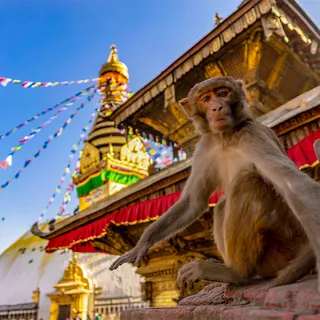
- View More Inclusions
- Flights from Kathmandu-Pokhara-Kathmandu and Kathmandu-Paro-Kathmandu
- Sustainable Development Fee & Taxes for Bhutan
- Bhutan visa fee
- Headsets throughout the tours
- All entrance fees
- Gratuities for guides, coach drivers, restaurant staff, and baggage handling at the hotels (covered in NDA fees)
- Olivia representative to accompany the group
- What's Not Included
- International roundtrip airfare to Kathmandu
- Nepal entry visa
- Alcoholic beverages
- Meals not listed
- Laundry services
- Optional flight to see Mountain Everest and Eastern Himalayan Range
- Travel insurance & personal incidentals
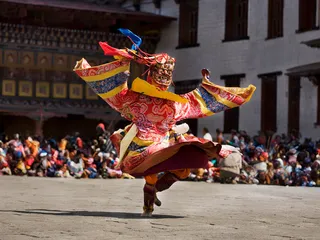
Itinerary
- Day 1Kathmandu, NepalFriday, Nov 7, 2025
Namaste and welcome to Nepal. The word “namaste” comes from Sanskrit and is used as a greeting and means “bowing to you” or “I bow to you”.
Upon your flight’s arrival to Kathmandu, you will be met after you exit your plane with a meet & greet service where you will be escorted to and assisted with the immigration and customs process and purchasing of your Nepal entry visa. You will be assisted with your luggage and transferred to your hotel. Check-in time at your hotel is 2 pm.
Depending on your arrival time, you are welcome to do some exploration on your own or take the time to relax after a long flight. This evening dinner is on your own.
Overnight at the Kathmandu Marriott Hotel.
- Day 2Kathmandu, NepalSaturday, Nov 8, 2025
After breakfast at the hotel, you will gather your things and depart for a full day’s adventure in Kathmandu.
The morning will begin with a tour of Bhaktapur Durbar Square. Known as Bhaktapur, meaning "city of devotees," this place is home to medieval art and architecture. Located 9 miles east of Kathmandu, Bhaktapur was founded in the 9th century and is shaped like a conch shell. The city sits at an elevation of 4,600 feet above sea level. Historically called Bhadgaon, Bhaktapur features Durbar Square, where you can explore an array of temples, including the Palace of 55 Windows built by King Bhupatindra Malla. Another notable site is the Nyatapola Temple, also constructed by King Bhupatindra Malla. This exemplary Pagoda-style temple stands on five terraces, each adorned with pairs of figures: two famous strong men, two elephants, two lions, two griffins, and two goddesses.
After lunch at a local restaurant in Bhaktapur, you will board your coach to visit the Nepal Youth Foundation (NYF) and NGO supported by Olivia and Olivia guests for the past many years. Founded by Olga Murray in 1990, NYF has helped over 60,000 children and families in Nepal gain access to high-quality education, healthcare, shelter, and freedom. As Nepal’s education system, healthcare infrastructure, social safety nets, and economy grow, NYF takes flexible and targeted steps to promote equality and prosperity for children across the country. The children supported by NYF are becoming Nepal’s teachers, engineers, NGO leaders, doctors, lawyers, green farmers, role models, care workers, and more. They are building strong families and giving back to their communities in remarkable ways.
After visiting NYF and learning all about their current programs, you will return to your hotel to get refreshed for your 6-course Welcome Dinner at Krishnarpan at the Dwarikas Hotel.
Overnight at the Kathmandu Marriott Hotel.
(B/L/D) - Day 3Kathmandu / Pokhara, NepalSunday, Nov 9, 2025
After breakfast at the hotel, you will board your coach for you transfer to the airport for your flight to Pokhara.
The rare combination of snow-clad peaks and snow fed lakes and rivers has helped to make the valley of Pokhara one of the most picturesque natural attractions in the kingdom. Sitting on Phewa lake it is located on the main road between Kathmandu and Bhairawa, there may be no other place in the world from where Great Himalayas’ peaks can be admired from such a close distance.
After checking into your hotel and a quick refreshment, you will head to a non-profit fair-trade organization known as the Women’s Skills Development Organization (WSDO), that has been working since 1975 to empower women who face difficult and significant social and economic hardships—being differently-abled, abused, widowed, divorced, single, orphaned or of marginalized castes.
Their aim is to empower economically disadvantaged women from rural Nepal by providing free vocational training and job opportunities to help them become self-sufficient. This vision originated from a group of women who recognized that equipping marginalized women with new skills could transform their lives and communities. They produce a diverse range of handwoven and handmade products, including handbags, cases, purses, toys, footwear, and household accessories.
Later, you will go lakeside for an evening of ‘Food Adventure’. Dotted along the lakeside there are numerous local shops, selling seasonal produce diced with fragrant spices. Most of these shops are run by local women. We will stop at one of these shops where a local female cook will teach you how to create some of the most delectable local dishes. This is also an evening for a chat and exchanging experiences with these women, besides the feasting.
Overnight is at the Sarangkot Mountain Lodge Pokhara.
(B/-/D) - Day 4Pokhara, NepalMonday, Nov 10, 2025
Start your day with a morning Yoga Session at The Mudra Studio. The studio is located Lakeside and offers beautiful views of the lake. This morning you will practice different forms of yoga including sun salutations with a serene sound bowl vibration to loosen your Chakra. Your class will be filled with some advanced students, who will make sure that everyone enjoys the class and is shown any modifications needed.
After your yoga class and breakfast, you will head to the International Mountain Museum. The mountains and the history of mountaineering are rich with stories that deserve to be preserved forever. To achieve this, the Nepal Mountaineering Association (NMA) established the International Mountain Museum (IMM) in Pokhara. The museum's primary objective is to record, document, and chronicle the past and present developments in mountaineering worldwide, with a special focus on the significant achievements in the Himalayan peaks. The Himalayan range in Nepal holds immense importance not only for mountaineers but also for geologists, environmentalists, and sociologists. It harbors countless mysteries and facts that scientists and researchers continue to explore. All these values and mysteries are showcased in the unique International Mountain Museum.
This afternoon, you will meet with women from The Amma Samuha (Mothers Group), a voluntary organization of local women dedicated to raising awareness about gender, social, and other issues affecting women in Nepal. The group began in the western part of Nepal, particularly among the Gurung community, a local hill tribe of the western Himalayas. With many of their spouses serving in the Army, these women took on the responsibility of managing daily village affairs. Over time, they formed groups to organize cultural activities for trekkers visiting the Annapurna and Dhaulagiri regions. The Amma Samuha would sing and dance to local tales, using the proceeds to improve trail conditions, maternal and child health, and other social initiatives.
This afternoon, you will have the opportunity to spend quality time with some of the local Ama Samuha. You will hear about their current projects, future plans, and ongoing struggles, and engage in local celebrations with dancing and singing. The day will conclude with a group meal at a local restaurant in Pokhara’s lakeside area.
Overnight at the Sarangkot Mountain Lodge Pokhara.
(B/L/D) - Day 5Pokhara / Kathmandu, NepalTuesday, Nov 11, 2025
After breakfast you will checkout of your hotel in Pokhara and go to the airport for your flight back to Kathmandu.
Upon arrival in Kathmandu, you will visit Patan Durbar Square, one of the three royal cities in the valley. Patan is a haven for connoisseurs of fine arts, featuring intricate wood and stone carvings, metal statues, and ornate architecture. The city boasts dozens of Buddhist and Hindu temples and over 1,200 monuments. Patan is believed to have been built in the 3rd century B.C. by the Kirat dynasty, expanded by the Lichhavis in the 6th century A.D., and further developed by the Mallas in the medieval period.
Durbar Square, akin to its Kathmandu counterpart, is a captivating blend of palace buildings, artistic courtyards, and graceful pagoda temples. Recognized as a UNESCO World Heritage Site, this former royal palace complex is the heart of Patan’s religious and social life. It also houses a museum that displays a diverse array of bronze statues and religious artifacts.
Next, you will continue to the Boudhanath Stupa, one of Nepal's oldest and largest Buddhist monuments. Boudhanath is revered as one of the holiest structures, standing at a height of 118 feet with three massive, Mandala-style platforms. It is surrounded by colorful buildings where families reside, creating a welcoming and friendly atmosphere.
Afterward, you will meet with a member of Seven Summit Women, a team of Nepali females who joined forces to summit Mt. Everest in 2008. Despite facing various socio-economic challenges, each member successfully reached the world's highest peak. Following this milestone, the team set out to conquer the tallest mountain on each continent. In 2014, they achieved another historic feat by becoming the first all-female group in the world to summit the Seven Summits. During lunch, you will have the opportunity to meet with one of the summiteers and hear about their journey to conquer all seven peaks.
The remainder of the day and evening are yours to rest or to explore Kathmandu at your leisure. You can visit Thamel, the city’s main nightlife area, which is brimming with restaurants, bars, and markets. Take some time to shop, enjoy a meal, and soak in the lively atmosphere of Kathmandu.
Dinner is on your own and overnight at the Kathmandu Marriott Hotel.
(B/L/-) - Day 6Kathmandu, Nepal / Thimphu, BhutanWednesday, Nov 12, 2025
After breakfast today, you will fly to Bhutan. The flight to Paro offers some of the most spectacular views in the Himalayas, as you soar along the majestic mountain range.
Upon arrival in Bhutan, you will drive to Thimphu, the capital city. The route takes you through the Paro valley to the confluence of the Paro and Thimphu rivers at Chuzom. Just before reaching Chuzom, you'll see Tamchog Lhakhang, a temple dedicated to the 13th-century saint Thangthong Gyalpo, who built the bridge over the river.
After checking in at the hotel, you will visit the National Memorial Chorten, a large white structure crowned with a golden spire, located near the center of Thimphu. This iconic monument attracts many locals who come to circumambulate the chorten, spin the large red prayer wheels, and pray at a small shrine inside the gate. The paintings and statues within the monument offer deep insights into Buddhist philosophy.
This evening, you will attend a presentation by a local expert on Bhutan’s Developmental Philosophy of Gross National Happiness (GNH). Coined by King Jigme Singye Wangchuck in 1972, GNH emphasizes a holistic approach to progress, valuing non-economic aspects of well-being equally with economic growth. It aims to build an economy rooted in Bhutanese culture and Buddhist spiritual values rather than material development measured by GDP. Today, GNH guides Bhutan's five-year planning and development policies.
Dinner and overnight at the Pemako Thimphu.
(B/L/D) - Day 7Thimphu, BhutanThursday, Nov 13, 2025
After breakfast, you will go on a 4-mile nature hike, with an elevation gain of 1,000 feet, to Cheri monastery, a Buddhist monastery in Bhutan established in 1620 by Ngawang Namgyal, 1st Zhabdrung Rinpoche, the founder of the Bhutanese state. An elaborate decorated silver chorten inside the upper monastery enshrines the ashes of Zhabdrung's father. It is believed that Guru Rinpoche meditated in a cave above the monastery when he came to Bhutan in 8th century. The trail commences by crossing a nicely covered traditional wooden bridge that spans the Thimphu Chhu (river) and then heads steadily up to the monastery. The steep nature trail offers a serene and tranquil experience, allowing you to breathe in the cool, fresh air beneath a magnificent, wooded canopy. The view from the top is stunning.
After your visit to Cheri Monastery and a picnic lunch in a scenic location, you will visit the Handmade Paper Factory and try your hand at the art of papermaking. The factory uses bark from Daphne and Dhekap trees to produce traditional paper. Here, you can observe the entire process of making handmade paper using ancient methods practiced for generations.
Next, you will take a short drive to Buddha Dordenma, located atop a hill in Kuenselphodrang Nature Park. This massive bronze statue of Shakyamuni, gilded in gold and standing 169 feet tall, fulfills an ancient prophecy discovered by Terton Pema Lingpa in the 8th century A.D. It is said to emanate an aura of peace and happiness to the world. Inside the Buddha Dordenma statue are 125,000 smaller Buddha statues, each also cast in bronze and gilded in gold.
The remainder of the day is at leisure. Dinner and overnight at the Pemako Thimphu.
(B/L/D) - Day 8Thimphu, BhutanFriday, Nov 14, 2025
After breakfast, drive to Pangri Zampa for an astrology session. Founded in the early 16th century, this complex is a college for traditional astrology. Buddhist Astrology helps understand cosmic cycles in relation to Buddhist philosophy and mythology. It emphasizes interdependence, a core Buddhist belief, highlighting the balance between our physical world and the conditions we were born into from a karmic perspective. This understanding helps us navigate life's choices while honoring the dynamic forces influencing us.
Next, you will visit the Bhutan Association of Women Entrepreneurs (BAOWE), an NGO dedicated to empowering economically challenged women and girls. BAOWE identifies business opportunities and provides training in entrepreneurship and financial literacy. Its mission is to alleviate poverty, generate income, and improve the livelihoods of disadvantaged women and girls. You will meet some of the members to learn more about the organization and its impact.
After, you will go to Heritage Home, Babesa for a cooking session on authentic Bhutanese cuisine, followed by lunch and then a visit to the Bhutan Nuns Foundation.
Founded in 2009, the Bhutan Nuns Foundation (BNF) supports girls and women in nunneries and nearby communities across Bhutan. BNF empowers and educates women, improves living conditions, boosts rural economies, and preserves Bhutan’s culture amid rapid development.
Later, you will visit Tse Organics and the Gagyel Lhundrup Weaving Centre.
Tse Organics is founded on the belief that creating a balance with the elements of nature is essential for wellness. They hand-blend unique luxury oils and skin products using traditional Bhutanese wisdom alongside contemporary technology.
The privately owned Gagyel Lhundrup Weaving Centre produces the finest traditional hand-woven textiles in the region. It promotes the traditional Bhutanese art of weaving and is renowned for producing ceremonial textiles.
You will end your day with a visit to Tashichho Dzong, also known as Thimphu Dzong, is an impressive fortress that serves as the seat of the Royal Government of Bhutan. It houses the throne room, offices of the king, secretariat, and the ministries of home affairs and finance. Other government offices are located in nearby buildings. Tashichho Dzong has been the seat of the Royal Government of Bhutan since 1962, following the relocation of the capital from Punakha to Thimphu.
Overnight at the Pemako Thimphu.
(B/L/D) - Day 9Thimphu / Punakha, BhutanSaturday, Nov 15, 2025
After breakfast on your way to Punakha, you will drive over Dochu-la Pass (10,130 feet). You'll stop briefly to admire the view and the chorten, mani wall, and prayer flags that decorate the highest point on the road. On clear days, you can see several peaks from this pass, including Masagang, Tsendagang, Terigang, Jejegangphugang, Kangphugang, Zongphugang, a Table Mountain in Lunana, and Gangkar Puensum, Bhutan's highest peak at 7,497m (24,596 ft).
At Dochula Pass, you will find 108 chortens or stupas known as Druk Wangyal Chortens, built by Ashi Dorji Wangmo Wangchuk, the eldest Queen Mother. These chortens are arranged in three layers: the first layer has forty-five chortens, the second has thirty-six, and the top layer has twenty-seven, all built around the main chorten.
Punakha served as the capital of Bhutan and seat of government until 1955, and it remains the winter seat of the Je Khenpo, the chief abbot. Blessed with a temperate climate and natural drainage from the Pho Chhu (male) and Mo Chhu (female) rivers, the fertile Punakha valley produces abundant crops and fruits. Located at an elevation of 1,300m (4,265ft) above sea level.
After lunch, visit Punakha Dzong, also known as the ‘Palace of Great Happiness’, built at the confluence of the Pho Chhu and Mo Chhu rivers in 1637 by Zhabdrung Ngawang Namgyal. This majestic dzong served as both the religious and administrative center of Bhutan in the past. It features a six-story, gold-domed tower and courtyards with religious statues that reflect the depth of history and spiritual tradition here. Your guide will provide insights into this intricate culture that has been established here for centuries.
Next, you'll take a short excursion to Chimi Lhakhang. Situated on a hillock in the center of the valley, Chimi Lhakhang, is also known as the Temple of Fertility. It is widely believed that couples who do not have children, but wish for one, are usually blessed with a child soon after praying at this temple. The trail to the temple leads across rice fields to the small settlement of Pana, which means ‘field’. A walk through the village near the temple will offer you rare glimpses into the daily life and lifestyle of the villagers.
Dinner and overnight at Dhensa Boutique Resort Punakha.
(B/L/D) - Day 10Punakha, BhutanSunday, Nov 16, 2025
In the morning, after breakfast, you will visit Sangchhen Dorji Lhuendrup Lhakhang Nunnery. Perched on a ridge amid pine trees and overlooking the valleys of Punakha and Wangduephodrang, Sangchhen Dorji Lhuendrup temple gleams brightly. It houses a 14-foot bronze statue of Avalokiteshvara, as well as statues of Guru Padmasambhava, Gautama Buddha, Zhabdrung Ngawang Namgyal, Tsela Namsum, the 21 Taras, and Tsepamay (Buddha of Longevity). The temple complex also includes a permanent higher learning and meditation center for nuns, where they receive religious training and life skill training such as tailoring, embroidery, statue making, and thangka painting.
Next, head to Gatshothang Farmhouse to meet Aum Karma Yangchen, the owner of this farmhouse built in 1970. A suspension bridge connecting the farm to the main road was added in 2008. The 21-acre property includes cowsheds, cornfields, vegetable gardens, a stone bath shed, and plenty of open space. Here, you'll experience farm life by helping with chores such as milking cows and making fresh butter and cheese.
Aum Karma is an award-winning designer and expert in traditional Bhutanese textile dyeing. She received a Seal of Excellence in 2010 for her handcrafted products and designed the Royal Gho for the King's Coronation in 2008. Today, Aum Karma will teach you about traditional dyeing in a hands-on workshop using organic plants and minerals.
You will enjoy lunch at the farmhouse before heading to Wangdue Phodrang town to visit Wangdue Phodrang Dzong. Founded by Zhabdrung Ngawang Namgyal in 1638, the dzong is situated on a high ridge between the Punak Tsang Chhu and Dang Chhu rivers, offering fantastic views of the valley below. Wangdue Dzong holds a special place in Bhutan’s history. Its strategic location allowed the Penlop (Governor) of Wangduephodrang to protect routes to Trongsa, Punakha, Dagana, and Thimphu, making him the third most powerful ruler after the Governors of Paro and Trongsa. The dzong was damaged by fire in 2012 but has recently been restored to its original grandeur.
Dinner and overnight at the hotel in Dhensa Boutique Resort Punakha.
(B/L/D) - Day 11Punakha / Paro, BhutanMonday, Nov 17, 2025
After breakfast, you'll drive along the scenic highway to Paro. Upon arrival, you'll check into your hotel before embarking on a day of exploration in Paro.
The picturesque valley of Paro encapsulates a rich culture, scenic beauty, and numerous myths and legends. It is home to many of Bhutan’s oldest temples and monasteries, the National Museum, and the country’s only international airport. At the northern end of the valley, Mount Chomolhari (7,314m / 23,996 ft) stands in white glory, with its glacial waters plunging through deep gorges to form the Pa Chhu (Paro River). Paro is also one of the most fertile valleys in Bhutan, producing a significant portion of the locally famous red rice from its terraced fields.
After lunch, you'll visit Ta Dzong, originally built as a watchtower and now home to the National Museum. The extensive collection includes antique thangka paintings, textiles, weapons and armor, household objects, and a rich assortment of natural and historic artifacts.
Next, you'll visit a traditional farmhouse for a session of Archery and Khuru. Bhutanese farmhouses are colorful, decorative, and traditionally built without using a single nail. The majority of Bhutan’s population continues to live as it has for centuries—in small, isolated farms and hamlets, surrounded by terraced fields of rice, maize, and buckwheat.
Archery is the national sport of Bhutan and an integral part of all special occasions. During village tournaments, teams of archers use bamboo bows (though modern compound bows are now common in cities) to shoot at targets only 30 centimeters in diameter from a distance of 130 meters. Archery competitions are among the most picturesque and colorful events in the country.
Khuru, a popular outdoor team sport, is often played during festivals and archery tournaments. The heavy wooden darts, pointed with 10-centimeter nails, are thrown at a paperback-sized target 10 to 20 meters away.
After playing a few games of Khuru and trying your hand at archery, you'll attend a special blessing ceremony at the farmhouse with the presence of a lama. This will be followed by the lighting of 108 butter lamps.
Dinner and overnight at the Zhiwaling Heritage Hotel Paro.
(B/L/D) - Day 12Paro, BhutanTuesday, Nov 18, 2025
After breakfast, you will embark on a hike up to Taktshang Monastery, also known as Tiger’s Nest. The round trip takes approximately 5 hours. This monastery is one of Bhutan’s most famous landmarks, perched on the side of a cliff 900 meters (2,952 feet) above the Paro valley floor. According to legend, Guru Rinpoche arrived here on the back of a tigress and meditated at this monastery, giving it the name ‘Tiger’s Nest’. Recognized as a sacred site, it was visited by Zhabdrung Ngawang Namgyal in 1646 and is now a pilgrimage destination for all Bhutanese to visit at least once in their lifetime.
During your hike, you will participate in a special ceremony of hoisting prayer flags. These flags are a significant part of Bhutanese culture and religious heritage, often seen around monasteries, chortens, dzongs, homes, bridges, and mountain roads. The colorful flags—red, blue, green, yellow, and white—add a vibrant touch to the landscape. Bhutanese people believe that with each flutter, the prayer printed on the flag is released into the air, carrying it to the heavens. The more the flag flaps, the greater its divine value, making this ceremony an integral aspect of Bhutanese spirituality.
In the late afternoon, you will visit the newly restored Drukgyel Dzong, located at the end of the valley. Built by Zhabdrung Ngawang Namgyal in 1646 to commemorate an early military victory over Tibetan invaders, the dzong's name means "Fortress of the Victorious Drukpa." Since its construction in 1649, Drukgyel Dzong served as an important defense base in the region until 1951 when it was destroyed by fire. Despite the destruction, the ruins continue to be protected as an important monument linking the people of Bhutan with the significant events that helped maintain the country’s sovereignty. On a clear day, visitors can enjoy a commanding view of Mount Chomolhari.
This evening, after donning traditional Bhutanese attire, you will enjoy a Farewell Dinner accompanied by a traditional cultural program. Bhutanese art, dance, drama, and music all have deep roots in Buddhist religion, with music playing a key role in transmitting social values. Traditional Bhutanese music spans various subgenres, from folk to religious songs. The dances, performed in ornate costumes and masks, each carry symbolic meanings. The extraordinary grace and vibrant colors of these energetic and dramatic dances often leave a lasting impression on visitors.
Overnight at Zhiwaling Heritage Hotel Paro.
(B/L/D) - Day 13Paro, Bhutan / Kathmandu, NepalWednesday, Nov 19, 2025
This morning after breakfast, you will go to the airport for your flight back to Kathmandu and then your international flight home. May the memories of this once-in-a-lifetime trip fill your soul for years to come!
(B/-/-)
Your Curated Experiences
Olivia has exclusive experiences that will provide you with access to breathtaking natural landscapes and rich cultural encounters. From awe-inspiring vistas to vibrant local traditions, you'll be amazed by the beauty and spirit of these stunning destinations.
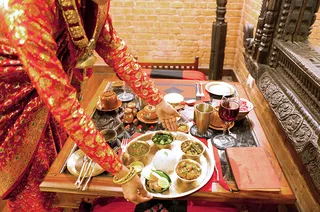
Accommodations at the Finest Hotels
- Kathmandu Marriott Hotel | Kathmandu
The Kathmandu Marriott Hotel is a five-star hotel situated near top shopping, dining and attractions, the hotel offers a perfect location within walking distance of Durbar Marg and Narayanhiti Palace Museum. The hotel has six onsite restaurants ranging from international cuisine to authentic Asian cuisine, the Raksi Music Bar, a fully equipped 24-hour fitness center, the M Wellness Spa, and outdoor swimming pool.
- Sarangkot Mountain Lodge | Pokhara
Located in the hills of the Sarangkot, you will enjoy stunning views of the Annapura mountain range at the Sarangkot Mountain Lodge from almost every location in the hotel. There are 28 deluxe rooms and 2 suites all with spectacular views of the mountains and the Seti River below. The hotel has one restaurant, Gurans, named after the national flower of Nepal, with views looking out of the mountains while you dine, a rooftop bar and Annapura Pool located on the rooftop with mountains as your backdrop and the Tripti Spa offering a wide range of treatments form massages to facials.
- Pemako Thimphu Hotel | Thimphu
Nestled in the vibrant heart of Bhutan's capital, Pemako Thimphu is easily accessible to all important centers of the town. A sanctuary for self-discovery and awakening, it evokes the aura of a medieval fortress, where age-old traditions seamlessly intertwine with contemporary comforts. The hotel has two restaurants, Chig Ja Gye and The Thongsel, a bar, Ara, and the Lotus Realm Spa that offers treatments based on the five elements of Traditional Bhutanese Medicine: water, wood, fire, earth, and metal.
- Dhensa Boutique Resort | Punakha
The Dhensa Boutique Resort sits in the heart of the tranquil and lush Punakha Valley. Flanked by thick pine forests, it overlooks the Punakha River, and hundreds of paddy fields that stair-step down to the valley floor. The hotel has one restaurant that offers home-style Bhutanese cooking, and Western and Asian dishes using all local and organic produce and the Kibu Spa that offers a variety of spa treatments, steam & sauna rooms, an outdoor wood-fire hot tub, and a yoga/meditation room.
- Zhiwaling Hotel | Paro
Located in the charming valley of Paro, Zhiwaling Heritage offers a truly exceptional experience, enhancing every aspect of your trip. A 5-star hotel, Zhiwaling is seamlessly integrated with nature, culture, and tradition. Zhiwaling has the Lingka and Hawa Restaurants, the Mad Monk Bar, a tea house, an in-house temple, a wellness spa, meditation house, and fitness center.
Pricing
EARLY-BIRD PRICES EXPIRE 5/15/2025.
Prices shown reflect all current discounts. Prices are per person (PP) based on double occupancy. Pricing does not include airfare, insurance, fuel surcharge, or nondiscountable amount (NDA). Per-person NDA of $599 (subject to change) covers taxes, fees, and gratuities.
Payment Plans
Two payment plan options are available when booking online or through a Travel Consultant:
1. Olivia Interest Free Payment Plans: Olivia payment plans must be paid in full six months or 180 days before your trip. If a reservation is made at the six-month mark or less, payment in full will be required unless otherwise noted.
2. Flex Pay Loans: Need to extend your payments over more time? Apply for a Flex Pay loan!
How To Book
This trip is not available for online booking. Please book your vacation with a Travel Consultant, Monday - Friday: 8:30am-5:30pm PT.
U.S.A.: 800.631.6277 | INT'L: 1.415.962.5700 | Email: [email protected]
We accept Discover, MasterCard, and Visa.
Cancellation Policy & Travel Insurance
Unexpected events can cause you to cancel your vacation. Because we are committed to this charter, we must strictly adhere to our cancellation policy as outlined in our Olivia Terms & Conditions. Transfer funds are nonrefundable and nontransferable from the point of sale forward.
Olivia recommends that you purchase a travel protection plan to help protect you and your trip investment against the unexpected. Visit our Insurance page at olivia.com/travel-insurance for more information. For a travel insurance quote, more information or to purchase a protection plan, please call Olivia at 800-631-6277 and select option 1 for a Travel Consultant. You may also purchase insurance online after your checkout.
Cancellation Fees
- 365 days or more prior to trip date: on or before 11/7/2024
Cancellation Penalty: 50% of trip cost
- 0-364 days prior to trip date: 11/8/2024-11/7/2025
Cancellation Penalty: 100% of trip cost (no refund)
Vacation Stretchers
DEADLINE TO BOOK IS JUNE 20, 2025 OR UNTIL SOLD OUT
If you are interested in booking a Vacation Stretcher, please call your Travel Consultant at 800-631-6277 and select option 1.
Pre-Trip Vacation Stretcher: 1-Night Hotel Package, Kathmandu Marriott Hotel
To avoid the stress of unexpected delays and for anyone that wants to arrive early, relax, and do a little sightseeing on your own before our main program begins on November 7, we will be offering a 1-Night hotel package November 6-7.
- Inclusions
- A transfer from the Tribhuvan International Airport to the Kathmandu Marriott Hotel,
- All taxes
- Breakfast, on Friday, November 7, 2025.
- Price
- $159 PP — Double Occupancy
- $289 PP — Single Occupancy
Post-Trip Vacation Stretcher: Chitwan National Park
2-Nights, Chitwan National Park (November 19-21, 2025): Join us for an unforgettable adventure in Chitwan National Park, one of Nepal’s most iconic and biodiverse landscapes. Nestled at the base of the Himalayas, this UNESCO World Heritage Site offers a rare opportunity to explore untouched nature and encounter wildlife found nowhere else on earth. From a serene canoe ride along the Rapti River to a thrilling jeep safaris and guided jungle walk, you’ll have a front-row seat to see the rare one-horned rhinoceros, exotic birdlife, and—if we’re lucky—the elusive Bengal tiger. Beyond the wilderness, you’ll connect with the rich culture of the indigenous Tharu and Kumal communities, who welcome us with vibrant traditional dances and a glimpse into their way of life.
Whether you're a nature enthusiast, wildlife photographer, or simply curious to experience something new, Chitwan offers a once-in-a-lifetime journey through Nepal’s wild heart all in the company of other Olivians!
Optional Experiences
- Mountain Flightseeing
Take to the skies for an unforgettable journey over the Himalayas on a mountain flight from Kathmandu. In just under an hour, this scenic flight offers panoramic views of some of the world’s highest and most iconic peaks including Mount Everest, Lhotse, and Makalu. Every passenger is guaranteed a window seat, ensuring unobstructed views of snow-covered ridgelines, deep valleys, and glacial landscapes. Flight attendants offer in-flight maps and commentary, highlighting key peaks and landmarks as you fly parallel to the majestic mountain range. With flights operating early in the morning to take advantage of the clearest skies, this is a convenient and awe-inspiring way to witness the beauty and scale of the Himalayas.
Inclusive of roundtrip transfer from hotel to airport and escort to the airport, through check-in and to the gate.
PRICE: $305 PP
Traveler Info
- About Our Destination
Climate
The climate in Nepal in November can be warm in Kathmandu and Pokhara with daytime temperatures ranging from 70°–76°F and 43°–51°F at night. In Thimphu and Paro, the average daytime temperatures range from 50°–63°F and 30°–41°F in the evening. In Punakha, the average daytime temperatures range from 63°–70°F and 45°–52°F in the evening. Check www.weather.com for the most current weather.
Currency
The official currency in Nepal is the Nepalese Rupee and in Bhutan is the Bhutanese Ngultrum. Check www.xe.com for current rates.
Languages
The official language in Nepal is Nepali and is spoken by 78% of the population and Maithili is the second most spoken language. Nepal has 121 other languages that are recognized as national languages.
The official language in Bhutan is Dzongkha, a Sino-Tibetan language, also known as Bhutanese.
- Before Your Trip
Celebrations — Birthdays, Anniversaries, Honeymoons, and more
If you will have a birthday or celebration during your vacation and have not already informed your Olivia Travel Consultant, please let us know as soon as possible, but no less than 90 days prior to the trip.
You can register at Olivia Honeymoon Wishes for your honeymoon, anniversary, or other special celebration; browse through the selections and let your friends know just how easy it is for them to purchase a gift for you.
Connect with Other Guests: Join the Facebook Group
If you'd like to chat with people who are going on the trip, join Olivia’s 2025 Himalayan Harmony: A Nepal & Bhutan Adventure Facebook Group.
Passport and Visa
All guests (including guests from countries other than the United States) will be required to have a passport. Passports must be valid for six months after your return date. All visitors are required to have a minimum of two blank pages in their passport to allow for an entry stamp. If there is insufficient space in the passport, entry into the country will be denied.
US citizens need a visa for entry into Nepal. Multiple entry visas may be purchased upon arrival for $30 for 15 days, $50 for 30 days. A visa to enter Bhutan is required and is included in the cost of your trip. If you are not a US citizen, please check visa requirements with your country’s consulate and the consulates of the countries you’ll be visiting.
Specific Needs: Dietary, Medical, Mobility, and Other
If you have any medical, mobility, dietary, or other special requirements that you haven't yet shared, please reach out to [email protected] as soon as possible. To verify if we can accommodate your needs, kindly do so at least 90 days before your trip.
Vaccinations
Please check with your local Public Health Department or personal physician regarding immunization requirements for all countries on your itinerary. You may also check the Centers for Disease Control and Prevention’s website at: www.cdc.gov. Just click on “Traveler’s Health” followed by “Vaccinations.”
- Travel & Arrival
Air Travel
Airport
You will need to fly into and out of Kathmandu Tribhuvan International Airport (KTM). We encourage all guests to arrive a day early to avoid the stress of unexpected delays.
Airfare Specials: Airfare discounts for this trip are not available through our partner airlines.
Flight Arrival and Departure Times: You can arrive at any time on Friday, November 7, 2025. Departures from the Kathmandu Tribhuvan International Airport (KTM) on Wednesday, November 19, 2025, should be after 1 pm.
Transfers and Meeting Up with Olivia
You will be provided with VIP Meet & Greet Arrival Assistance upon your arrival in Kathmandu. With this service, you will be met at after exiting the plane by a dedicated representative that will escort and assist you through an accelerated immigration and customs process and then into the baggage claim. Your luggage will be handled by porters that will take your luggage to your group transfer vehicle. You will be transferred from the airport to the hotel, where you are pre-registered for check-in.
- During Your Trip
Electricity
Nepal
The standard voltage is 230 V in Nepal. The power plug sockets are type C (also works with plugs E & F), type D (only works with plug D) and type M (only works with plug M) with type C being the more prevalent. As outlets sometimes vary, if you plan to operate electric appliances, we suggest you travel with a set of international adapter plugs as well as a voltage converter.Bhutan
The standard voltage is 230 V in Bhutan. The power plug sockets are type D (works with only plug D), type F (also works with plug C and E) and type G (works only with plug G) with type C being the more prevalent. As outlets sometimes vary, if you plan to operate electric appliances, we suggest you travel with a set of international adapter plugs as well as a voltage converter.Most camera batteries, cell phones and computer chargers have the 110/220/230-V converters built in, but double check this. With the proper adapters, you can easily re-charge your batteries in all the accommodations.
Excursions
While in Kathmandu, there will be an option to book a Mountain Flightseeing trip that will fly you over Mount Everest and the Eastern Himalayas. More information about prebooking will be provided 11 months prior to the trip.
Gratuities
Gratuities, including to your hotel staff (except for room service and laundry delivery), porter, driver/guide, and restaurant staff are included. If you received exceptional service from someone, you are welcome to give an additional gratuity. If you book an optional excursion, it is appropriate to tip your guide.
Internet
Complimentary wifi is available at all of the hotels.
Laundry Services
Laundry, pressing, and dry-cleaning services are available at the hotels for an extra charge. Pricing is available at each hotel and may vary depending on the hotel.
Medical Services
Should you require medical assistance, medical and health facilities are widely available in all of the major cities you are traveling through. If medical assistance is needed while you are in a more rural area, there are pharmacies that can assist with treatment. Medical treatment is available for a fee.
Phone
We suggest you check with your carrier about cell phone service in Nepal and Bhutan. Complete information about emergency contact information will be available in your final documents, which will be emailed to you 4 weeks in advance of the trip.
Smoking Policy
Please refrain from smoking in enclosed places where it may affect others.
- After Your Trip
Transfers to the Airport
On the final day of the trip, November 19, 2025, you will fly from Paro, Bhutan, to Kathmandu, Nepal, where you will catch your international flight home. We recommend booking your flight home for after 1 pm to allow ample time between your arrival from Paro and your international departure.
Still Have Questions?
Speak to a Travel Consultant by calling 800.631.6277 (Option 1) during business hours: Monday–Friday 8:30am -5:30pm PT or submit a contact request.
Other Trips You'll Love
![2025 Canary Islands Luxury Cruise]() Limited2025 Canary Islands Luxury CruiseDec 10, 2025 - Dec 20, 2025See the best of the Canary Islands with Olivia!BOOK ONLINE OR CALL AN OLIVIA TRAVEL CONSULTANT
Limited2025 Canary Islands Luxury CruiseDec 10, 2025 - Dec 20, 2025See the best of the Canary Islands with Olivia!BOOK ONLINE OR CALL AN OLIVIA TRAVEL CONSULTANT![2026 Dublin to Edinburgh Luxury Cruise]() 2026 Dublin to Edinburgh Luxury CruiseJun 17, 2026 - Jun 25, 2026Find Magic in Ireland and Scotland with Olivia!
2026 Dublin to Edinburgh Luxury CruiseJun 17, 2026 - Jun 25, 2026Find Magic in Ireland and Scotland with Olivia!![2026 Australia's Kimberley Coast Adventure Cruise]() 2026 Australia's Kimberley Coast Adventure CruiseAug 04, 2026 - Aug 14, 2026Encounter diverse wildlife and remote, pristine landscapes, with Olivia!
2026 Australia's Kimberley Coast Adventure CruiseAug 04, 2026 - Aug 14, 2026Encounter diverse wildlife and remote, pristine landscapes, with Olivia!![2026 Tahiti Luxury Cruise]() 2026 Tahiti Luxury CruiseSep 03, 2026 - Sep 10, 2026Experience tropical paradise in pure luxury with Olivia!BOOK ONLINE OR CALL AN OLIVIA TRAVEL™ CONSULTANT
2026 Tahiti Luxury CruiseSep 03, 2026 - Sep 10, 2026Experience tropical paradise in pure luxury with Olivia!BOOK ONLINE OR CALL AN OLIVIA TRAVEL™ CONSULTANT











